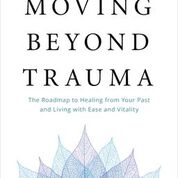Moving Beyond Trauma by Ilene Smith
 Moving Beyond Trauma
Moving Beyond Trauma
by Ilene Smith
In my early forties, after a career in banking and real estate financing, I returned to school for a master’s degree in mental health counseling. I truly had no idea that this path would lead me to my greatest passion in life thus far.
During my internship to complete my degree, I was introduced to Somatic Experiencing for trauma healing, a modality developed by Peter Levine, PhD. What distinguishes Dr. Levine’s work from other trauma-informed therapies is the importance of bringing the body into the therapeutic process. I had spent years in talk therapy, which was effective in bringing awareness to my issues and their origins, but I still felt an underlying dysregulation in my nervous system. I was anxious and continued to battle my eating disorder demons.
When I incorporated SE techniques into my own life and my clients’ therapeutic processes, I saw our nervous systems move towards more balanced states in only a few sessions. Marriages improved and depressions lifted. As a result of less stress and anxiety in my body, my eating disorder behaviors began to quiet.
SE uses a “clinical map” to access the physiological states of survival known as fight, flight, and freeze and helps release the self-protective and defensive responses we hold in our body. It includes talking, but the talking is used to track body sensation and meaning attached to experiences, rather than bring the individual back into the event of the trauma.
I wanted to bring the possibilities of Somatic Experiencing to a larger audience; I wanted more people to understand that while our perception of trauma and healing is often associated with cognition, in order to heal on a cellular level, we need to invite the body into the process. And so, the task of creating Moving Beyond Trauma: The Roadmap to Healing from Your Past and Living with Ease and Vitality began.
I knew that if I was going to impact the audience, I needed to empower people to take charge of their own healing. As my ideas took shape, I realized it wasn’t enough to explain the benefits of SE. Readers needed a way to customize the information to meet their unique needs, and so the book evolved into a roadmap for healing the nervous system and creating a personalized healing lifestyle.
 Almost a year-and-a-half after I began work on the book, I answered my doorbell to find the box of 50 author copies of Moving Beyond Trauma on my doorstep. As I opened it, adrenaline rushed through my body. I was overcome with excitement, but also fear. I believe the book carries an important message about trauma and healing, and I also know that any time we stick our necks out for our beliefs, criticism often follows.
Almost a year-and-a-half after I began work on the book, I answered my doorbell to find the box of 50 author copies of Moving Beyond Trauma on my doorstep. As I opened it, adrenaline rushed through my body. I was overcome with excitement, but also fear. I believe the book carries an important message about trauma and healing, and I also know that any time we stick our necks out for our beliefs, criticism often follows.
However, my desire to carry the message of this work outweighs my fear. I believe the general public doesn’t have enough information about the mind-body connection in the healing process and many aren’t aware of how small changes can bring the nervous system back into balance.
The book includes six assessments to help the reader better understand how trauma impacts their nervous system and day-to-day functioning. Many psychologists focus on “fixing” patients’ problematic or maladaptive behaviors. Researcher Sarah Melancon, PhD, and I set out to develop tools that assess the current functioning of a patient’s nervous system so that they can create their own intentional plan to increase its health and functioning, which will “fix” the problem behaviors organically.
Dr. Melancon and I spent months developing these assessments, along with detailed instructions on how to use the information. After finishing the book, we took our work one step further and went on to complete a study on SE and eating disorders, which we hope to see published later this year.
For those struggling with mental health issues, I hope that Moving Beyond Trauma motivates them to take charge of their healing. After they complete the book, I anticipate that they will begin to feel differently and more grounded in their physical experience, or “embodied.” When we feel the physicalness of our bodies we can be more present. Presence allows us to be more curious about ourselves and the world around us. It gives us a richer experience of life and a deeper sense of safety, both of which are key for creating a sustainable healing lifestyle.
The process of birthing a book is like no other, and it has certainly been one of my greatest challenges thus far. It asked me to uplevel my self-care. I had to slow my nervous system down even further. I minimized my travel schedule, recommitted to my yoga practice, and made sure I sought support from trusted friends. Routine, discipline, and connection with friends and family were key in helping me stay in my creative flow.
Creating Moving Beyond Trauma required me to use all the tools I write about! I am pleased to report they worked as well as I imagined they would. I hope that you’ll invite me into your own healing journey and pick up a copy of Moving Beyond Trauma should you feel so called.
ABOUT THE AUTHOR:
Ilene Smith is the author of Moving Beyond Trauma: The Roadmap to Healing from Your Past and Living with Ease and Vitality. She is a certified professional coach and Somatic Experiencing practitioner who is passionate about helping others explore life with curiosity and exuberance. Her research into Somatic Experiencing and eating disorders has contributed to the importance of Somatic Experiencing and body-based therapies in recovery. Ilene has also worked extensively with patients suffering from addiction. With master’s degrees in exercise physiology and mental health counseling, Ilene blends talking, touch work, and movement to create synergy between a client’s body and mind. In addition to her private practice, Ilene has developed a series of trauma healing workshops and lectures, which she hosts worldwide. She lives in Arizona. For more information, please visit http://ilenesmith.com/ and follow Ilene on Facebook and Instagram
MOVING BEYOND TRAUMA
 Have you noticed that no matter how much time you spend in talk therapy, you still feel anxious and triggered? That is because talk therapy can keep you stuck in a pattern of reliving your stories, rather than moving beyond them. But, most of all, it’s because trauma doesn’t just reside inside your mind—much more importantly, it locks itself in other parts of your body. When left unresolved, that trauma continues to live there, impacting your life, your relationships, your sense of safety, and your ability to experience joy in very real ways.
Have you noticed that no matter how much time you spend in talk therapy, you still feel anxious and triggered? That is because talk therapy can keep you stuck in a pattern of reliving your stories, rather than moving beyond them. But, most of all, it’s because trauma doesn’t just reside inside your mind—much more importantly, it locks itself in other parts of your body. When left unresolved, that trauma continues to live there, impacting your life, your relationships, your sense of safety, and your ability to experience joy in very real ways.
In Moving Beyond Trauma, Ilene Smith will introduce you to Somatic Experiencing, a body-based therapy capable of healing the damage done to your nervous system by trauma. She breaks down the ways in which trauma impacts your nervous system and walks you through a program designed to process trauma in a non-threatening way. You will discover a healing lifestyle marked by a deeper connection with yourself, those around you, and with everything you do.
Category: Contemporary Women Writers, How To and Tips

























